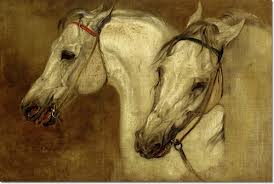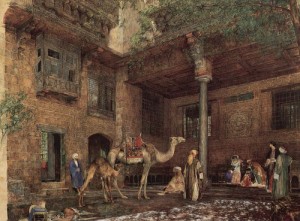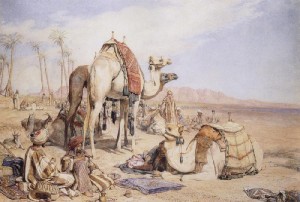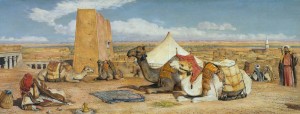John Frederick Lewis for Thursday Art Day
I found ‘Two Arab Horse Heads’ by chance and it took me some time to find out who painted them. When I found Lewis’ Eastern art, the camels, the desert and the architecture I fell in love with his interpretation of the Eastern customs of life. Of course my favourite has to be Two Arab Horse Heads I thought the composition showed two horses anxious for another day in the great deserts but full of gentle manners.
John Frederick Lewis – Two Arab horse heads 1870
John Frederick Lewis (14 July 1804 – 15 August 1876) was an Orientalist English painter. He specialized in Oriental and Mediterranean scenes and often worked in exquisitely detailed watercolour. He was the son of Frederick Christian Lewis (1779–1856), engraver and landscape-painter.
Lewis lived in Spain between 1832 and 1834. He lived in Cairo between 1841 and 1850, where he made numerous sketches that he turned into paintings even after his return to England in 1851. He lived in Walton-on-Thames until his death. Lewis became an Associate of the Royal Academy (ARA) in 1859 and a member (an RA) in 1865.
After being largely forgotten for decades, he became extremely fashionable, and expensive, from the 1970s and good works now fetch prices into the millions of dollars or pounds at auction.
John Frederick Lewis – Home of the artist in Cairo 1851
The Victorian Web http://www.victorianweb.org states:
John Frederick Lewis is the one of finest of the Orientalist painters. Because of his painstaking “Pre-Raphaelite” technique, his finished paintings are rare. Of all of the European and American artists to make the Eastern Pilgrimage in the nineteenth century, he was the only one to stay on for an uninterrupted ten years. He settled in the native quarters of Cairo in 1841, returning to London in 1851 with a body of work from which he drew inspiration for the next twenty-five years. His character was a paradox: his dandy nature manifested itself in London in the most fashionable and extrovert clothes and in Cairo in the robes of an Egyptian nobleman. This lifestyle was in contrast to his fervent wish to escape from the “civilisation” of city life. His greatest pleasure was to spend long periods in the desert hinterland in his encampment under the Egyptian starlit nights.
John Frederick Lewis – A halt in the Desert
Despite the critical acclaim that his exhibits earned him, he was disheartened by the lack of financial reward. In the late 1850s he almost abandoned watercolour, exhibiting mainly, but not exclusively, in oils. In 1859, his election to Associate of the Royal Academy prompted a letter from his old friend David Roberts the next day, addressed to: John F Lewis RA, RA RA. RA, RA, RA! John Ruskin, who formed a close friendship with the artist, wrote, after his death: “Watercolour drawing can be carried no further, nothing has been left unfinished or untold.” – Sally Burgess
John Frederick Lewis – Edfu, Upper Egypt
http://www.enzieshahmiri.com




Leave a Reply